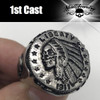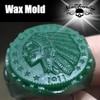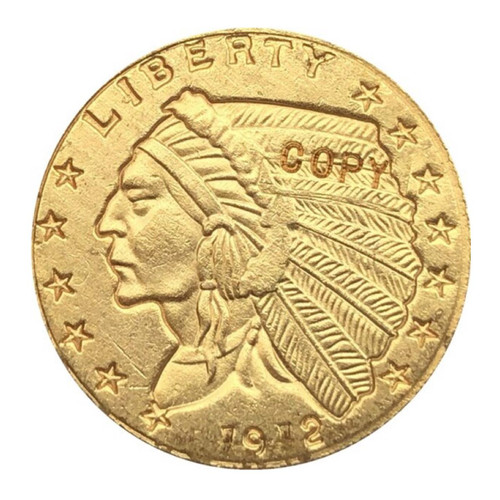'Hobo Coin' Indian Gold Quarter Eagle Ring
The altering of coins dates to the 18th century or earlier.
Our new Quarter Eagle "Hobo Coin" is our version of the famous coin turned into a skull ring.
The original quarter eagle coin is one of the rarest and most sought after coins in the world. While the value of an original Quarter Eagle coin can fluctuate based on market value the rarest year is the 1911.
We chose the design for our new Hobo Coin based on the Quarter Eagle coin due to it's beauty and rarity.
With the exception of the profile of a Native American on an original Quarter Eagle we have left the rest of the coin as you would find it on an original coin with only one slight modification. The original coin has the initials DLP after the original designer of the coin. SkullJewelry.com has changed the initials to J.R. after our founder.
History of the Quarter Eagle Coin:
The Indian Head gold pieces aka The Quarter Eagle was struck from 1908 to 1915 and from 1925–1929. The pieces remain the only US circulating coins with recessed designs. These coins were the last of their denominations to be struck for circulation, ending series that began in the 1790s.
President Theodore Roosevelt, from 1904, vigorously advocated new designs for United States coins, and had the Mint engage his friend, the sculptor Augustus Saint-Gaudens, to design five coins (the four gold pieces and the cent) that could be changed without congressional authorization. Before his death in August 1907, Saint-Gaudens completed designs for the eagle ($10 piece) and double eagle, although both required subsequent work to make them fully suitable for coining.
With the eagle and double eagle released into circulation by the end of 1907, the Mint turned its attention to the half eagle and quarter eagle, originally planning to duplicate the double eagle's design. The Mint had difficulty fitting the required inscriptions on the small gold coins. President Roosevelt, in April 1908, convinced Mint Director Frank Leach that it would be a better idea to strike a design similar to that of the eagle, but below the background, to secure a high-relief effect. Such coins were designed by Boston sculptor Bela Lyon Pratt at the request of the President's friend, William Sturgis Bigelow. After some difficulty, the Mint was successful in this work, though Pratt was unhappy at modifications made by the Mint's engravers, headed by longtime Chief Engraver Charles E. Barber.
The quarter eagle was struck each year through 1915. While "hard money" circulated in quantity in the West, in the East banknotes were much more common. A common use of the small gold pieces was as Christmas presents—the pieces would be produced at the various mints late in the year, be purchased from banks in December and return to vaults by late January. The establishment of the Federal Reserve System in 1913 increased the circulation of banknotes, and the Mint ceased to strike quarter eagles after 1915.
A near mint 1911 Quarter Eagle coin can fetch as much as $4,000.
Our Quarter Eagle Hobo Coin ring is made from 316L stainless steel which can easily last a lifetime.
It absolutely will not fade… rust… corrode… change color… or leave stains on your fingers. Plus it requires no maintenance to retain its raw “fresh-out-the-box” machismo. You like… she likes… get one for each of you.
- Sizes Available: 07-16
- Style: "Hobo Coin" Stainless Steel Ring
- Material: 316L Stainless Steel w/Gold overlay
- Weight: 26 grams (0.9 ounce)
NOTES: There are a few of the images which are of wax molds and an artist rendering. The actual ring may differ slightly from what is pictured.
CLICK HERE to buy the matching pendant
Call Us at 1-866-457-5855




























